2016 Polaris 800 Indy SP Review
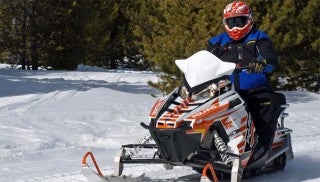
The big Indy SP provides a rush of traditional values
If you liked last year’s 800cc Indy SP, chances are you’ll like the latest version equally as well. That’s our snarky way of saying little to nothing has changed. Figure that the 800 Indy SP is a year more mature.
Interestingly, when Polaris divvied up the goodies to create a limited edition for model year 2016, they went to the 600cc version of the popular Indy SP to create the 2016 600 Indy SP Terrain Dominator LE. Not the higher performance 800cc Indy SP! Guess that tells you which Indy sells better.
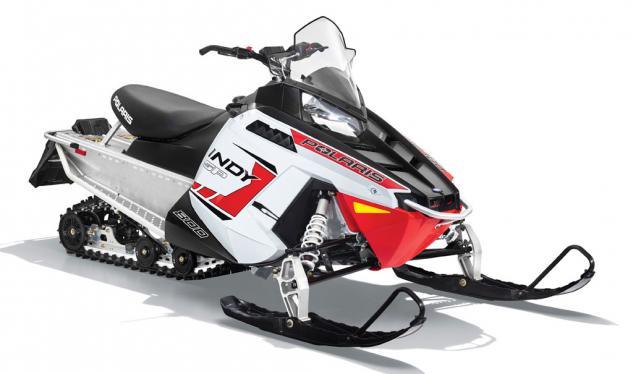 The base in-season 800 Indy SP is available in white with red and black trim, but with plenty of room for add-ons.
The base in-season 800 Indy SP is available in white with red and black trim, but with plenty of room for add-ons.The move gave the Indy line four fun-to-ride models that allowed value buyers four options from good, better, best and most performance, that being the higher performance criteria of the 800 Indy SP. It works. Look at the pricing. The base 600 Indy starts at US$8,199. To move up to the better equipped 600 Indy SP costs you US$1000. To add the Terrain Dominator features, which included a retro paint job and decals, you paid another US$800 for that limited edition upgrade. If you crave big bore power from an 800cc two-stroke twin, you’d pop for the 800 Indy SP, which would move your bottom line another US$1000 to US$10,999.
COMPARISON: Read our review of the 2016 Polaris 600 Indy SP
Pricewise, this represents some clever marketing thought, especially when you figure that all four of these sleds are basically the same, simply upgraded with slightly different or better pieces. Over a range of $2800, Polaris provides value buyers with some serious options for the money.
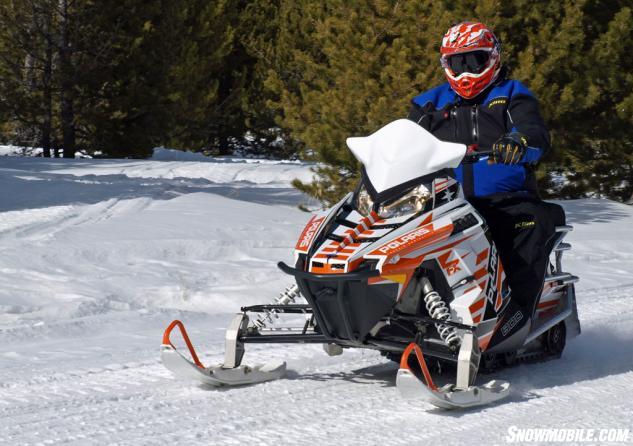 You don’t have to settle for the everyday Indy as Polaris proved when it provided us with this tricked out orange-wrapped 800 Indy SP with a white wind screen and coordinated coil springs on the Fox shocks.
You don’t have to settle for the everyday Indy as Polaris proved when it provided us with this tricked out orange-wrapped 800 Indy SP with a white wind screen and coordinated coil springs on the Fox shocks.What you get from the 800 Indy SP versus the base 600 Indy is quite a bit, especially in performance. While the 800 adds quite a bit of punch compared to any of the 600 Indy versions, we would like to have seen the 800 Indy SP come standard with the Terrain Dominator’s 1.25-inch lugged Ripsaw track instead of the standard 15-inch wide by 121-inch long Hacksaw track with a modest 1.0-inch lug height. The benefit to the taller lugs would be grip, especially under wide open throttle, which we expect most 800 Indy SP owners will use frequently. Why else did they pop for the extra displacement?
Compared to the 600 Indy SP, the 800cc version is very similar. All of these budget trail models are based on the Polaris Pro-Ride chassis, a straight aluminum tunnel that combines with a lowered and centralized engine bay. You won’t find much difference under the hood as the two Liberty two-strokes are similar in external dimension and fit nicely to afford reasonable access for servicing the drive belt, adding oil and such basic maintenance needs. The two engines feature Polaris’ proprietary semi-direct Cleanfire electronic fuel injection system, which offers easy cold weather starting – with or without electric start – and flawless throttle response. Modern fuel injection is far superior to even the best carbureted designs of the past. Fortunately, all of these 600s and the 800 come standard with the Cleanfire feature.
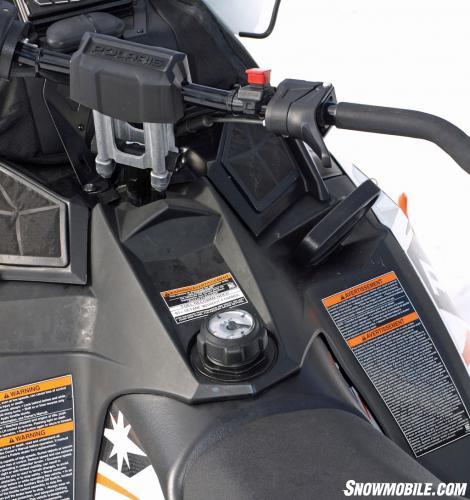 There is no affectation to the Indy SP. It has an easy to read mechanical gauge, curved handlebar ends for cornering, a 3.5-inch riser and easy access, easy pull D-grip starter.
There is no affectation to the Indy SP. It has an easy to read mechanical gauge, curved handlebar ends for cornering, a 3.5-inch riser and easy access, easy pull D-grip starter.While the two engines may look similar from the outside, the output is considerably different and a big plus for 800 Indy SP owners, who enjoy a solid 20-plus horsepower advantage versus Indy 600 riders! That being said, do understand that the Indy’s 800cc twin is not the same as the engine currently housed in the 2016 Rush or new–for-2016 AXYS RMK mountain series. Those AXYS models all have the latest AXYS hood design that facilitates air flow to the HO-designated engine, which also uses a new three-stage electronically controlled exhaust valve, a lighter weight crankshaft and such. The 800 Indy twin is the older engine design, but it still packs a substantial wallop on the trail without spanking your wallet too hard! Value, remember!
COMPARISON: Read our review of the 2016 Arctic Cat XF 6000 CrossTrek + Video
The 800 Indy SP would be the top of the line performance sled if Polaris hadn’t invented the Rush. It uses a race-proven chassis that’s fitted with a race-proven double A-arm front suspension and a conventional coupled parallel rail rear suspension. This set up bears some similarity to the rear suspension common to the pre-2015 RMK Assault models, but obviously has much shorter rails to accommodate a 121-inch track versus a 155-inch powder track. The rear suspension works its nearly 14 inches of travel with Fox internal floating piston gas shocks. The base Indy relies on more modest RydeFX MPV shocks over the same stroke. The same differences apply to the front suspension where all SP models come standard with Fox gas shocks. That’s where some of the price differential between base and SP version ends up.
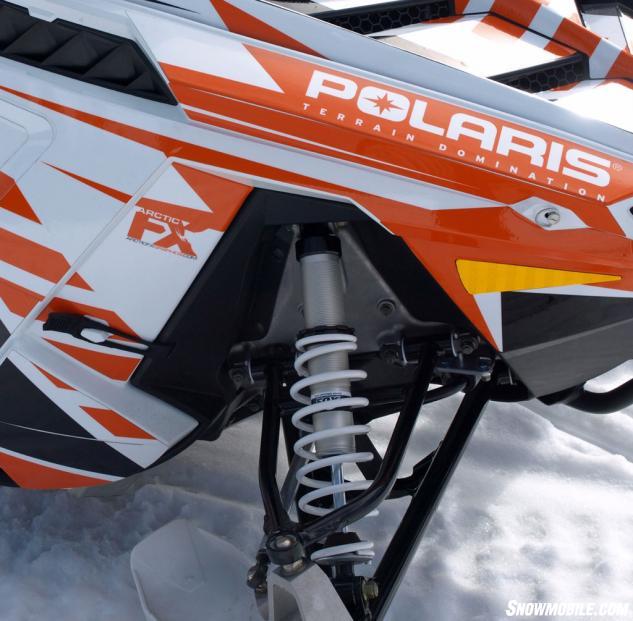 Although Fox internal floating piston shocks are standard on all Indy SP models for 2016, you can add color-coordinated coil springs to create a unique custom look.
Although Fox internal floating piston shocks are standard on all Indy SP models for 2016, you can add color-coordinated coil springs to create a unique custom look.Overall, we found the Indy SP really terrific and fun to ride on groomed trails. Although the 800 SP may provide a rush on the trail, it is not a Rush. To get the kind of ride and performance an 800 Rush Pro-S gives you means you have to add another US$1600 to the price of the 800 Indy SP. Plus; they are two completely different experiences.
While the Indy SP is a truly excellent all-around groomed trail cruiser, it has its limitations, especially in long sections of stutter bumps, where the throwback design chatters and gets a bit unsettled at high speeds. But if you ride on well-maintained trails like those in Ontario, Quebec, Minnesota and Wisconsin, this sled is hard to beat for its performance value. It is quick, responsive and exceptionally adept in the corners. Much of its handling prowess comes from the Fox-supported front suspension and the top line Pro-Steer skis. The ski’s keel features a short-ish skag to minimize steering effort and reduce darting.
COMPARISON: Read our review of the 2015 Yamaha Viper S-TX DX
If you’re like us, you’ll be at one with the Indy SP as soon as you lay a leg over. The Pro-Ride saddle tapers at the front for excellent side to side movement. The center of the seat is wide and firm for you to sit comfortably for long straights. Its design invites all manner of optional storage bags, which, of course, your Polaris dealer will be happy to sell you. The standard SP windshield is a mid-height style, but you can opt for lower racer-spec or tall wind-blocking versions in various tint or color combinations.
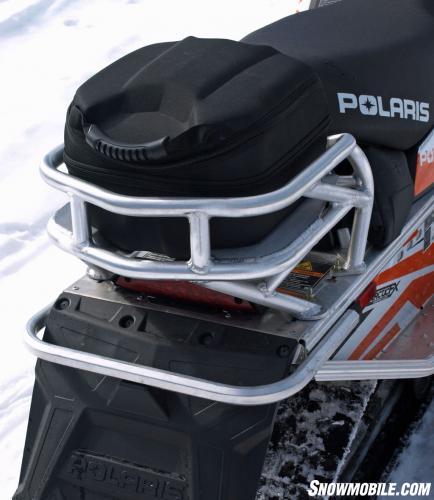 If want to stand out on the trail with your value Indy, check out the Polaris options catalog that offers storage solutions like this optional fitted rear rack with semi-hard luggage components.
If want to stand out on the trail with your value Indy, check out the Polaris options catalog that offers storage solutions like this optional fitted rear rack with semi-hard luggage components.One of the things that we like about all the Indys is the complete lack of affectation. These sleds are fully functional with no pretense of being anything other than what they are – value sleds with traditional core values. Think of them as that childhood friend who knows you all too well. When you ride an Indy, you know it like a best friend. It has a curved handlebar to facilitate sport cornering. The gas gauge is in the fuel cap, which is mounted in front of you. Nothing fancy, simply efficient. Handling is exactly as you expect. Power is reliable and durable.
The drive system is similarly friendly. The P85 drive clutch is an old Polaris buddy, but now it’s paired with a proven TEAM driven to maximize power transfer to the track. The drive system works – and has worked since the days when Polaris claimed more Winnipeg-to-St. Paul endurance titles than all other sled makers combined. The Indy is history.
The 2016 800 Indy SP offers strong performance and equally strong value. This is not a retro sled, but a modern re-interpretation of a legend that propelled Polaris to market dominance for than a decade. No previous Indy had the performance of the 2016 800 Indy SP. This Indy is its own legend, with all the right stuff.
| 2016 Polaris 800 Indy SP | 2016 Polaris 600 Indy SP Terrain Dominator LE | 2016 Polaris 600 Indy SP | |
| Engine | Polaris Liberty 795cc twin cylinder 2-stroke; liquid-cooled; Cleanfire semi-direct fuel injection | Polaris Liberty 599cc twin cylinder 2-stroke; liquid-cooled; Cleanfire semi-direct fuel injection | Polaris Liberty Cleanfire 599cc twin cylinder 2-stroke; liquid-cooled; Cleanfire semi-direct fuel injection |
| Horsepower | 140-plus | 120-plus | 120-plus |
| Drive | Polaris P-85 drive, TEAM LWT driven | ||
| Front Suspension | Polaris Pro-Ride; 9-in maximum travel; Fox IFP shocks; Pro-Steer skis | ||
| Rear Suspension | Polaris Indy slide rail; Fox IFP shocks; 13.9-inch maximum travel | ||
| Length | 114.0 in | ||
| Width | 48.0 in | ||
| Height | 48.0 in | ||
| Ski Stance | 42.5 in | ||
| Track | 15 x 121 x 1.0 Hacksaw | 15 x 121 x 1.25 Ripsaw II | 15 x 121 x 1.0 Hacksaw |
| Weight | 449 lbs (claimed) | ||
| Brake | Polaris Phantom hydraulic | ||
| Features | Standard: Pro-Steer skis; Indy Pro-Ride seat; fixed 3.5-in riser; electronic reverse; one-piece handlebar with hook ends; multi-function display Options: electric start; 12v outlet; rear rack; windshield options | Standard: Pro-Steer skis; Indy Pro-Ride seat; electric start; fixed 3.5-in riser; electronic reverse; one-piece handlebar with hook ends; digital multi-function display Options: 12v outlet; rear rack; windshield options | Standard: Pro-Steer skis; Indy Pro-Ride seat; fixed 3.5-in riser; electronic reverse; one-piece handlebar; multi-function display; analog speedometer Options: electric start; 12v outlet; rear rack; windshield options |
| Fuel Capacity | 11.5 US Gal | ||
| MSRP | $10,999 | $9,999 | $9,199 |




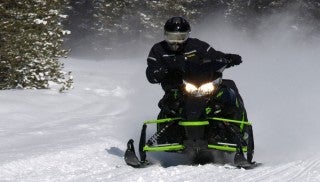
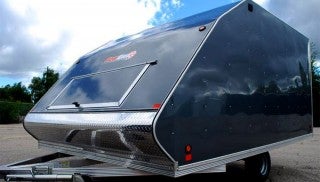


 Your Privacy Choices
Your Privacy Choices